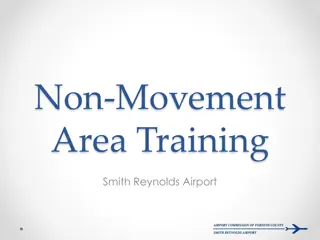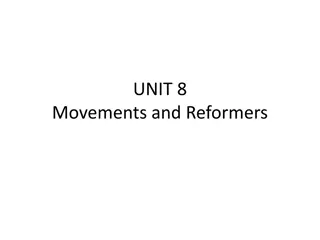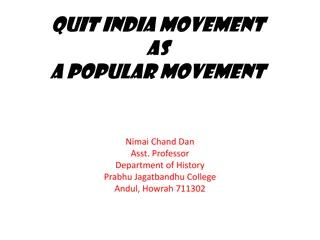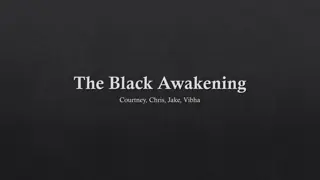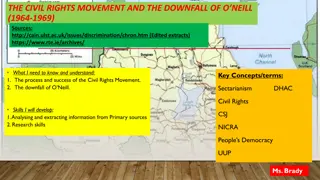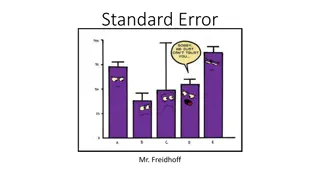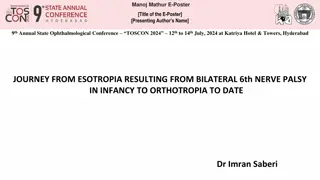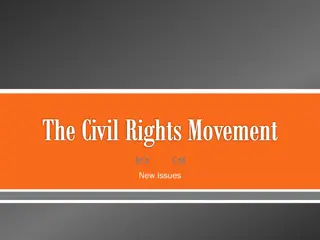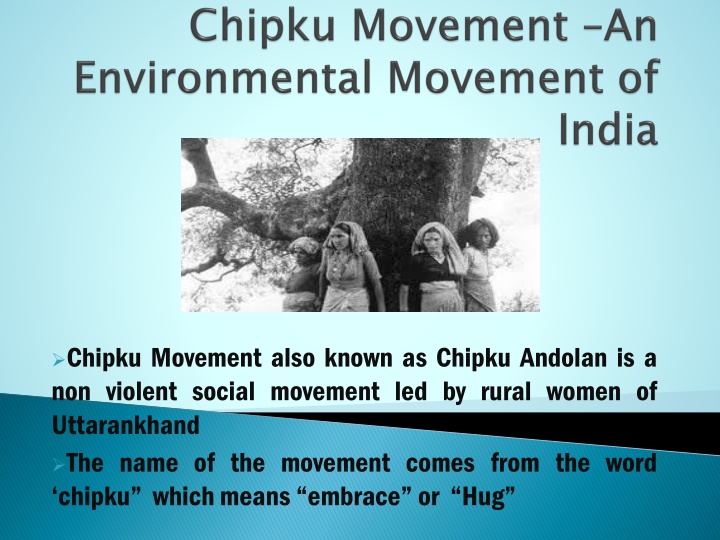
Chipko Movement: Non-Violent Environmental Protest Led by Rural Women
The Chipko Movement, also known as Chipku Andolan, is a non-violent social movement led by rural women in Uttarakhand. Originating from the word "chipku" meaning embrace or hug, the movement aimed to protect the environment, secure rights, and prevent deforestation. Starting in the 1970s, the movement gained momentum, with protests leading to significant victories against government-backed logging. Led by activists like Sunderlal Bahuguna, the movement expanded its efforts to include reforestation and ecological preservation, leaving a lasting impact on the region's ecosystem.
Uploaded on | 0 Views
Download Presentation

Please find below an Image/Link to download the presentation.
The content on the website is provided AS IS for your information and personal use only. It may not be sold, licensed, or shared on other websites without obtaining consent from the author. If you encounter any issues during the download, it is possible that the publisher has removed the file from their server.
You are allowed to download the files provided on this website for personal or commercial use, subject to the condition that they are used lawfully. All files are the property of their respective owners.
The content on the website is provided AS IS for your information and personal use only. It may not be sold, licensed, or shared on other websites without obtaining consent from the author.
E N D
Presentation Transcript
Chipku Movement also known as Chipku Andolan is a non violent social movement led by rural women of Uttarankhand The name of the movement comes from the word chipku whichmeans embrace or Hug
To protect the environment. To secure their rights. To protect the trees and forest from government backed logging.
Due to colonial forest policy forest land in the Himalayan Region reduced rapidly .After independence the Govt. of India started forest destruction in this region in the name of development of transport &communication particularly in the decade of 1960.As a result the rural villagers had to face many problems regarding their food and fuel directly and soil erosion ,rain&water indirectly.In search of food and fuel the local people of this region had to migrate to the plain areas.In such experience activities of government. people came out against deforestation
In 1964 environmentalist and Gandhian social activist Chandi organization, Dasholi Gram Swarajya Sangh (later renamed Dasholi Gram Swarajya Mandal [DGSM]), to foster small industries for rural villagers, using local resources. When industrial logging was linked to the severe monsoon floods that killed more than 200 people in the region in 1970, DGSM became a force of opposition against the large-scale industry. The first Chipko protest occurred near the village of Mandal in the upper Alaknanda valley in April 1973. Prasad Bhatt founded a cooperative cont .
With the success in Mandal, DGSM workers and Sunderlal Bahuguna, a local environmentalist, began to share Chipko s tactics with people in other villages throughout the region. One of the next major protests occurred in 1974 near the village of Reni, where more than 2,000 trees were scheduled student-led summoned the men of the surrounding villages to a nearby city for compensation, ostensibly to allow confrontation. However, they were met with the women of the village, led by Gaura Devi, who refused to move out of the forest and eventually forced the loggers to withdraw. to be felled. Following the a large demonstration, government the loggers to proceed without cont
As the movement continued, protests became more include the entire ecology of the region, ultimately movement. Bahuguna marched 5,000 km (3,100 miles) across the Himalayas to bring the movement to prominence. Throughout the 1980s many protests were focused on the Tehri dam on the operations, resulting in the closure of at least one limestone quarry. Similarly, a massive reforestation effort led to the planting of more than one million trees in the region. project-oriented and expanded to becoming Between the 1981 Save Himalaya and 1983, Bhagirathi River and various mining
Sunderlal Bahuguna was born in village Maroda near Tehri, Uttarakhand on 9 January 1927. He claimed in a function arranged at Kolkata, that his ancestors migrated from Bengal to Tehri, some 800 years ago. Early on, he fought against untouchability and later started organising hill women in his anti-liquor drive from 1965 to 1970. He started social activities at the age of thirteen, under the guidance of Shri Dev message of non-violence and he was with the Congress party of Uttar Pradesh (India) at the time of Independence.Bahuguna against adopted Gandhian principles in his life and married his wife Vimla with the condition that they would live among village.Inspired Himalayan forests and hills, covering more than 4,700 kilometres on foot and observed the damage done by mega developmental projects on the fragile eco-system degradation of social life in villages. bearing surname Bandyopadhyaya, Suman, who was a nationalist spreading also mobilised before people 1947.He colonial rule rural people by and establish he ashram through in Gandhi, walked of the Himalayas and subsequent
He changed the former Motto of the movement- Ecology is permanent Economy . Soil is ours, water is ours, ours are these forests, our forefathers raised them, its our duty to protect them. Forest Satyagrah- named by the media. In 1987 Chipko movement was awarded Right Livelihood Award .
The news soon reached the state capital, where the then state Chief Minister, Hemwati Nandan Bahuguna, set up a committee to look into the matter, which eventually ruled in favour of the villagers. This became a turning point in the history of eco-development struggles in the region and around the world. The movement achieved a victory when the government issued a ban on felling of trees in the Himalayan regions for fifteen years in 1980 by then Prime Minister Indira Gandhi, until the green cover was fully restored. One of the Bahuguna, took a 5,000 kilometre trans-Himalaya foot march in 1981 83, spreading the Chipko message to a far greater area. prominent Chipko leaders, Gandhian Sunderlal
Active participation of women Democratic movement Non-Violent and Social movement. Expose environmental consciousness.





